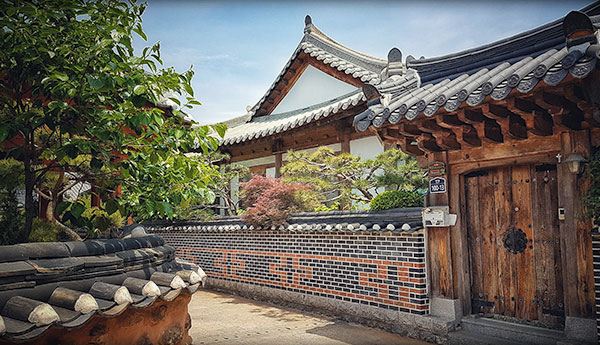
Harmonious, unique, simple but full of style, the charming and eco-friendly traditional Korean houses, called Hanok – 한옥 in the local language, began to be built in the fourteenth century, during the Joseon Dynasty.
The typical architectures of the Asian peninsula have managed, with some difficulty, to survive the relentless building development of the 70s that led South Korea to be the modern country that today is full of new apartments, skyscrapers and gigantic condominium complexes that look like Matrix-style hives, all the same, and built in every Korean city.

The Hanok – 한옥 are harmonious buildings, designed considering the surrounding natural environment and the coexistence of human beings with the latter. Built following the principles of Feng Shui, which we can think of it as Chinese geomancy, studying the energies of the place to decide the right positioning of the house. Consideration is also given to the rules dictated by the baesanimsu – 배산임수, which literally means mountain behind and river in front.

The construction materials originally used to build Hanok – 한옥 are mainly wood, rock and soil: eco-friendly, recyclable and natural elements. The roof is made of tiles, the supporting beams, the floors and fixtures by wood, the walls and floors is clay and rock and the windows and doors by paper (called hanji). Obviously, the modern Hanoks, which are set among various buildings or that can be visited in some traditional villages, are built using also some new materials and even the old ones have been restored to fit to the current living conditions.

South Korea has rather cold winters and hot summers, as a result, the Hanok – 한옥 have been designed in such a way that they can stay cool using a parquet floor, called “daecheongo” and built with an ingenious underfloor heating system, or “gudeul “, which keeps the temperature comfortably warm and ensures peaceful nights, sometimes you sleep better on the floor than on mattresses! Systems still used in modern Korean homes. The clay used for the walls, floors and ceilings is also a perfect thermal insulator.

The Hanok – 한옥, usually have different shapes to adapt to the characteristics of the place, especially climatic. You can find straight structures in the hottest South, “L” shapes (or in local letters “ㄱ”) in the central regions to favor better air circulation and square shapes (“ㅁ” in Korean) in the colder regions to the north, to block the cold wind.
Where to see Hanok in South Korea
The Hanok – 한옥 can be admired almost everywhere, often stuck between high-rise buildings or other modern buildings, there are several villages where typical Korean houses have been preserved and that you can visit:
Bukchon Hanok Village, in central Seoul. People still live here, among tourists and visitors who crowd the streets of this beautiful example of a traditional Korean village every day.
Namsangol Hanok Village, in Seoul near the Namsan mountain. Opened in 1998, this village has five renovated Hanok, a pavilion and a traditional garden.
Hahoe Folk Village, a traditional village of the Joseon dynasty located in Andong, a few hours from the capital of South Korea and the city of Busan.
Gyeongju Yangdong Folk Village, a traditional village of the Joseon dynasty in Gyeongju in an attractive natural landscape, part of the UNESCO World Heritage Sites.
Jeonju Hanok Village, is located in Jeonju, one of the largest and perhaps my favorite Hanok village with more than 800 traditional houses. The town of Jeonju is also a pleasant place to visit, a couple of hours from Seoul.
Jeju Folk Village, on the beautiful island of Jeju, in the south of the country, with more than 100 straw-roofed Hanok!

If you are traveling and exploring South Korea, you will surely come across an Hanok – 한옥: besides being a great opportunity for a photographic shoot and really beautiful to look at on the outside, you can also visit them, as some have been used for cafes or restaurants (for example, there are many in Ikseon-dong district in Seoul and the surrounding area), others in shops and artists’ studios and I recommend you book a couple of nights in one of these typical Korean houses that many become a guest house, a perfect opportunity to have a true Korean experience!



